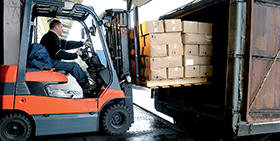The Romanian sector of road freight transport closes 2013 with profit

2013 was marked by a slower growth of the turnover in terms of superior profitability compared to 2012 where the significantly increasing revenues were accompanied by losses. The investments increased (a similar evolution as in 2012), but were funded in a defective way or by a very low degree of capitalization. More than half of the companies reported a negative working capital during 2013, without respecting the principle of resource allocation maturity on long-term contracts within investments.
According to the financial statements published by the Ministry of Finance, 27,252 companies whose main activity was the "road freight transport" during 2013 generated a total turnover of 26.6 BRON up by 8% from the previous year.
If considering the distribution of these companies by turnover it can be noted that 25% of the companies that filed the statements for 2013 did not really develop any activity and only 1,010 firms in this sector registered an annual turnover of more than 1 MEUR, generating about 64% of the revenues registered in the entire sector.
Following the structure of the profit & loss account for the companies in the sector and its impact on the figures registered in the consolidated balances, we noticed that, unlike 2012, which registered a sectorial advance of the total turnover of 15% with 70% of the companies achieving growth revenue, 2013 was marked by a slowdown from this point of view. Thus, the consolidated turnover’s advance at a sectorial level in 2013 was 8%, compared to the previous year, given that only 57% of the companies reported growth revenues.
Despite this, the net result had a better evolution, both in terms of absolute values and its dynamics. Thus, the values registered for this indicator at the sectorial level for 2013 were 1% compared to -1% in the previous year.
Taking into consideration the resources in terms of attracting funds and the allocation of resources for long-term investments, Coface estimates that during 2013, the analyzed companies allocated significant resources for investments to increase the number of fixed assets; but slightly down from the previous year.
The indebtedness registered at sectorial level decreased from 90% (2012) to 85% for 2013, but the share of indebted companies is still very high. Specifically, 5 of the 10 companies shows a negative capitalization degree (equivalent to a leverage more than 100%), which are predominantly small-sized firms or below average.
Liquidity ratios registered a slight trend of improvement at a sectorial level. Reduced liquidity indicators are the effect of keeping the profits in the companies and increasing the balances within banks and suppliers.
From the study conducted by Coface, it appears that the analyzed firms redistributed some of the funds raised on short term (running overdue invoices to suppliers, ensuring a constantly growing supplier-credit and increasing debt balances for the banks) for long-term investments, given that the level of capitalization was very low. Thus, they paid their debts to suppliers 24 days later than when they might have done it if they hadn’t diverted a part of the commercial credit to long-term investments.
Following the stress test analysis, Coface identified that companies in the road freight transport sector registered a fragile liquidity situation very exposed to negative shocks, that may come from uncollected receivables or declining sales. Scenarios of the advance income stabilization or a contraction thereof, are quite likely, given that the industrial production’s growth rate slowed down during the first half of this year.
Sectorial risk analysis reveals that 4,295 companies from the road transportation sector ceased their activity during 2013, and of these a total of 41 companies registered a turnover of over 1 MEUR. However, the sector remains very competitive; the companies’ volume that ceased their activity during 2013 was approximately equal to the one of the companies founded in 2011 & 2012. Thus, the number of companies that ceased operation in relation to the newly established ones in a comparable period of one year) is almost 2.
Coface analyzed individually in terms of risk assessment and payment behavior, a sample of 2,752 companies from its existing portfolio, which generates about 61% of the total turnover registered in the entire transportation sector.
We noticed that 3 out of 4 analyzed companies reveals an insolvency risk higher than the average, one third of them registering a high risk.
Taking into consideration the payment system, about 55% of the companies actually pays with delays, or they don’t respect their contracts and only 20% respect the payment terms.
"We noticed that 2013’s revenues grew slower in terms of higher profits, but the latter are insufficient compared to the investments realized with the suppliers’ help. The liquidity situation remains fragile and the stress test scenario analysis confirms that the companies in the sector are exposed to the risk of non-collecting their receivables or of a lower turnover, so if these scenario happens in 2014, they cannot avoid the insolvency unless they will restructure. Given that the industrial production had a slow start within the first semester 2014/ 2013, then these scenarios, especially on lower incomes are quite likely.", said Constantin Coman, Country Manager, Coface Romania.
Contact
Diana OROS
Marketing and Communications Specialist
42 Pipera St., 6th Floor - 020112
District 2 - Bucharest
ROMANIA
T: +40 37 467 08 86
Email: diana.oros@coface.com



